Small overlap front: driver-side
Rating applies to 2017-25 models built after August 2016
Tested vehicle: 2017 Chrysler Pacifica Touring
The Chrysler Pacifica was introduced in the 2017 model year as a replacement for the Chrysler Town and Country minivan. The Chrysler Voyager, available new only to fleet buyers, was introduced in the 2020 model year and shares the same platform as the Pacifica.
Two tests of the Pacifica were conducted because the driver door was torn off its hinges in the first test. As a result, Fiat Chrysler strengthened the upper hinge and reinforced the joint between the door hinge pillar and inner body panel in front of the pillar. In the second test, the upper hinge held and the door stayed shut.
The small overlap frontal ratings listed below apply only to vehicles built after August 2016, that is after the door hinge improvements were made. (Information about when a specific vehicle was manufactured is on the certification label typically affixed to the car on the driver door or adjacent B-pillar.)
| Evaluation criteria | Rating |
|---|---|
| Structure and safety cage | |
| Driver injury measures | |
| Head/neck | |
| Chest | |
| Hip/thigh | |
| Lower leg/foot | |
| Driver restraints and dummy kinematics | |
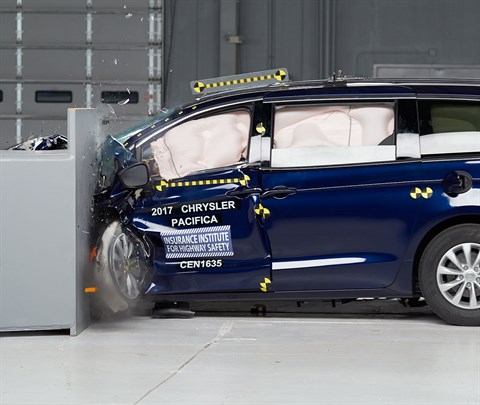
Action shot taken during the driver-side small overlap frontal crash test of the 2017 Chrysler Pacifica built after August 2016.
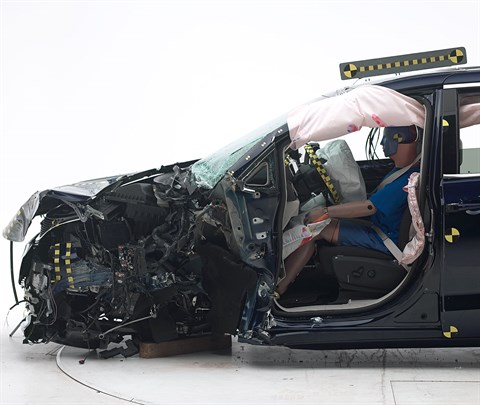
The dummy's position in relation to the door frame, steering wheel, and instrument panel after the crash test indicates that the driver's survival space was maintained reasonably well.
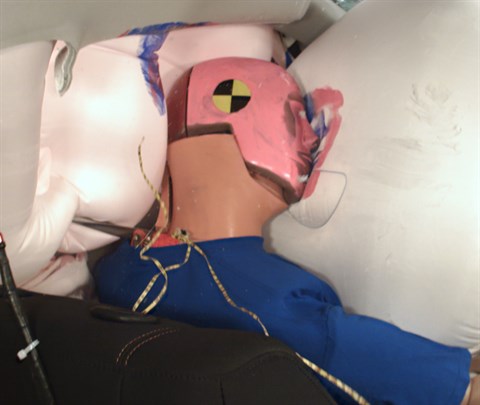
The frontal and side curtain airbags worked well together to keep the head from coming close to any stiff structure or outside objects that could cause injury.
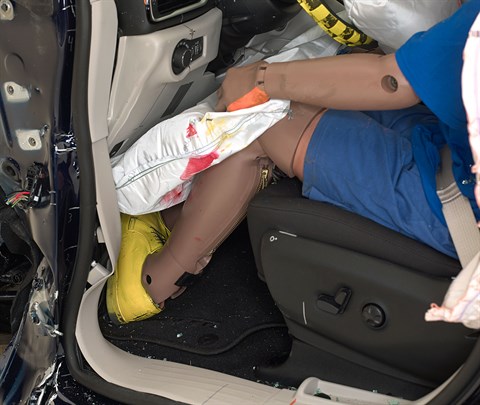
The driver's space was maintained reasonably well, and risk of injuries to the dummy's legs and feet was low.
Rating applies to 2017 models built before September 2016
Tested vehicle: 2017 Chrysler Pacifica Touring
The Chrysler Pacifica was introduced in the 2017 model year as a replacement for the Chrysler Town and Country minivan. The Pacifica does not share a platform with the Dodge Grand Caravan.
Two tests of the Pacifica were conducted because the driver door was torn off its hinges in the first test. As a result, Fiat Chrysler strengthened the upper hinge and reinforced the joint between the door hinge pillar and inner body panel in front of the pillar. In the second test, the upper hinge held and the door stayed shut.
The small overlap frontal ratings listed below apply only to vehicles built before September 2016, that is before the door hinge improvements were made. (Information about when a specific vehicle was manufactured is on the certification label typically affixed to the car on the driver door or adjacent B-pillar.)
| Evaluation criteria | Rating |
|---|---|
| Structure and safety cage | |
| Driver injury measures | |
| Head/neck | |
| Chest | |
| Hip/thigh | |
| Lower leg/foot | |
|
Driver restraints and dummy kinematics
The driver door was torn from its hinges and the door opened at the front, which shouldn't happen because the driver could be partly or completely ejected from the vehicle. Still, the dummy’s head loaded the frontal airbag, which stayed in front of the dummy until rebound. The side curtain airbag deployed and has sufficient forward coverage to protect the head from contact with side structure and outside objects. The side torso airbag also deployed. | |

Action shot taken during the small overlap frontal crash test of the 2017 Chrysler Pacifica built before September 2016.
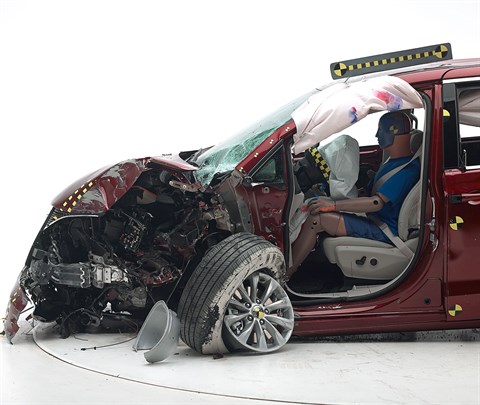
The dummy's position in relation to the door frame, steering wheel, and instrument panel after the crash test indicates that the driver's survival space was maintained well.
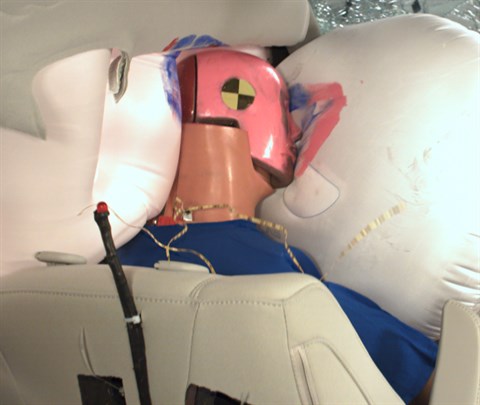
The frontal and side curtain airbags worked well together to keep the head from coming close to any stiff structure or outside objects that could cause injury.
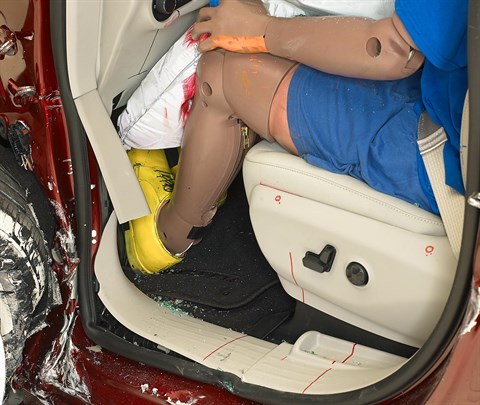
The driver's space was maintained well, and risk of injuries to the dummy's legs and feet was low.
Small overlap front: passenger-side
Rating applies to 2017-20 models built after August 2016 and before September 2020
Tested vehicle: 2018 Chrysler Pacifica L 4-door
The Chrysler Pacifica was introduced in the 2017 model year as a replacement for the Chrysler Town and Country minivan. The Chrysler Voyager was introduced in the 2020 model year and shares the same platform as the Pacifica.
Beginning with 2017 models built after August 2016, the upper hinge of both the driver and front passenger doors was strengthened and the joint between the door hinge pillar and inner body panel in front of the pillar was reinforced. (Information about when a specific vehicle was manufactured is on the certification label typically affixed to the car on the driver door or adjacent B-pillar.)
Two passenger-side small overlap frontal tests of the Pacifica were conducted, one by the Institute and the other by Fiat Chrysler. Ratings are based on both tests.
| Evaluation criteria | Rating |
|---|---|
| Overall evaluation | |
| Structure and safety cage | |
| Passenger injury measures | |
| Head/neck | |
| Chest | |
| Hip/thigh | |
| Lower leg/foot | |
| Passenger restraints and dummy kinematics | |
| Driver injury measures | |
| Head/neck | |
| Chest | |
| Hip/thigh | |
| Lower leg/foot | |
| Driver restraints and dummy kinematics | |

Action shot taken during the Institute's passenger-side small overlap frontal crash test.

The dummy's position in relation to the door frame and dashboard after the crash test indicates that the passenger's survival space was not maintained well (Institute test car shown).
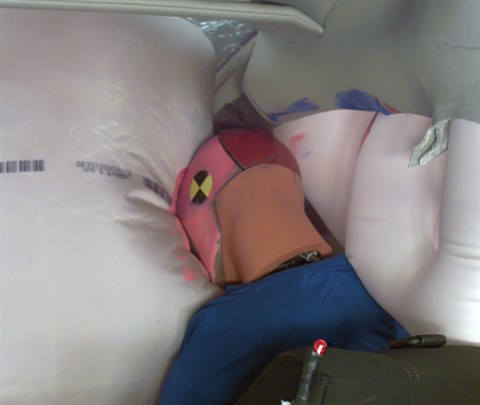
The frontal and side curtain airbags worked well together to keep the head from coming close to any stiff structure or outside objects that could cause injury (Institute test shown).

Despite intrusion of the door hinge pillar and dashboard in both tests, risk of injuries to the dummy's legs and feet was low.
Moderate overlap front: original test
Rating applies to 2017-25 models
Tested vehicle: 2017 Chrysler Pacifica Touring
The Chrysler Pacifica was introduced in the 2017 model year as a replacement for the Chrysler Town and Country minivan. The Chrysler Voyager, available new only to fleet buyers, was introduced in the 2020 model year and shares the same platform as the Pacifica. Moderate overlap frontal ratings are assigned by the Institute based on a test conducted by Fiat Chrysler.
| Evaluation criteria | Rating |
|---|---|
| Overall evaluation | |
| Structure and safety cage | |
| Driver injury measures | |
| Head/neck | |
| Chest | |
| Leg/foot, left | |
| Leg/foot, right | |
| Driver restraints and dummy kinematics | |
Side: original test
Rating applies to 2017-23 models
Tested vehicle: 2017 Chrysler Pacifica Touring
The Chrysler Pacifica was introduced in the 2017 model year as a replacement for the Chrysler Town and Country minivan. The Chrysler Voyager, available new only to fleet buyers, was introduced in the 2020 model year and shares the same platform as the Pacifica. Side ratings are assigned by the Institute based on a test conducted by Fiat Chrysler.
| Evaluation criteria | Rating |
|---|---|
| Overall evaluation | |
| Structure and safety cage | |
| Driver injury measures | |
| Head/neck | |
| Torso | |
| Pelvis/leg | |
| Driver head protection | |
| Rear passenger injury measures | |
| Head/neck | |
| Torso | |
| Pelvis/leg | |
| Rear passenger head protection | |
Roof strength
Rating applies to 2017-23 models
Tested vehicle: 2017 Chrysler Pacifica Touring
Ratings apply to the Chrysler Pacifica (tested) and the structurally similar Chrysler Voyager.
| Overall evaluation | |
|---|---|
| Curb weight | 4,378 lbs |
| Peak force | 20,056 lbs |
| Strength-to-weight ratio | 4.58 |
Head restraints & seats
Seat type: Power cloth seat
| Overall evaluation | |
|---|---|
| Dynamic rating | |
| Seat/head restraint geometry |
About the head restraint & seat test
Currently, IIHS tests apply only to front seats.
Headlights
Ratings are given for 5 different headlight variations available on this vehicle.
Trim level(s)
- Limited trim equipped with Advanced SafetyTec package
| Evaluation criteria | Rating |
|---|---|
| Low-beam headlight type | HID projector |
| High-beam headlight type | Halogen reflector |
| Curve-adaptive? | No |
| High-beam assist? | Yes |
|
Overall rating | |
| Distance at which headlights provide at least 5 lux illumination: | |
Low beams
On the straightaway, visibility was fair on both sides of the road. On curves, visibility was fair on the sharp left and both right curves and inadequate on the gradual left curve.
The low beams never exceeded glare limits.
High beams
On the straightaway, visibility was good on the right side of the road and inadequate on the left side. On curves, visibility was fair in all 4 tests.
High-beam assist compensates for some limitations of this vehicle's low beams on the straightaway and all 4 curves.
Trim level(s)
- Limited trim
| Evaluation criteria | Rating |
|---|---|
| Low-beam headlight type | HID projector |
| High-beam headlight type | Halogen reflector |
| Curve-adaptive? | No |
| High-beam assist? | No |
|
Overall rating | |
| Distance at which headlights provide at least 5 lux illumination: | |
Low beams
On the straightaway, visibility was fair on both sides of the road. On curves, visibility was fair on the sharp left and both right curves and inadequate on the gradual left curve.
The low beams never exceeded glare limits.
High beams
On the straightaway, visibility was good on the right side of the road and inadequate on the left side. On curves, visibility was fair in all 4 tests.
Trim level(s)
- Touring L trim equipped with Advanced SafetyTec package
- Touring L Plus trim equipped with Advanced SafetyTec package
| Evaluation criteria | Rating |
|---|---|
| Low-beam headlight type | Halogen projector |
| High-beam headlight type | Halogen reflector |
| Curve-adaptive? | No |
| High-beam assist? | Yes |
|
Overall rating | |
| Distance at which headlights provide at least 5 lux illumination: | |
Low beams
On the straightaway, visibility was fair on the left side of the road and inadequate on the right side. On curves, visibility was inadequate in all 4 tests.
The low beams never exceeded glare limits.
High beams
On the straightaway, visibility was fair on both sides of the road. On curves, visibility was inadequate in all 4 tests.
High-beam assist compensates for some limitations of this vehicle's low beams on the straightaway and all 4 curves.
Trim level(s)
- Touring L trim
- Touring L Plus trim
| Evaluation criteria | Rating |
|---|---|
| Low-beam headlight type | Halogen projector |
| High-beam headlight type | Halogen reflector |
| Curve-adaptive? | No |
| High-beam assist? | No |
|
Overall rating | |
| Distance at which headlights provide at least 5 lux illumination: | |
Low beams
On the straightaway, visibility was fair on the left side of the road and inadequate on the right side. On curves, visibility was inadequate in all 4 tests.
The low beams never exceeded glare limits.
High beams
On the straightaway, visibility was fair on both sides of the road. On curves, visibility was inadequate in all 4 tests.
Trim level(s)
- LX trim
- Touring trim
| Evaluation criteria | Rating |
|---|---|
| Low-beam headlight type | Halogen reflector |
| High-beam headlight type | Halogen reflector |
| Curve-adaptive? | No |
| High-beam assist? | No |
|
Overall rating | |
| Distance at which headlights provide at least 5 lux illumination: | |
Low beams
On the straightaway, visibility was inadequate on both sides of the road. On curves, visibility was inadequate in all 4 tests.
The low beams never exceeded glare limits.
High beams
On the straightaway, visibility was inadequate on both sides of the road. On curves, visibility was inadequate in all 4 tests.
Front crash prevention: vehicle-to-vehicle
Child seat anchors
Rating applies to 2017-19 models built after August 2016
| Evaluation criteria | Rating |
|---|---|
| Overall evaluation | |
| Vehicle trim | Touring |
| Seat type | cloth |
This vehicle has 4 rear seating positions with complete child seat attachment (LATCH) hardware.
| Evaluation criteria | Rating |
|---|---|
| Overall evaluation | |
| Vehicle trim | Touring |
| Seat type | cloth |
| Rating icon | Rating |
|---|---|
| G | Good |
| A | Acceptable |
| M | Marginal |
| P | Poor |
| Seating positions that rely on borrowed lower anchors or have only a tether anchor available are not rated. | |
thether anchor symbol | Tether anchor |
lower anchor symbol | Lower anchors |
| Lower anchor(s) can be borrowed from adjacent positions(s) | |
| No hardware available |
Details by seating position
| Position | Rating |
|---|---|
| 1 | |
| Tether anchor | |
| hard-to-find location | |
| no other hardware could be confused for anchor | |
| Lower anchors | |
| not too deep in seat | |
| too much force needed to attach | |
| difficult to maneuver around anchors | |
| 3 | |
| Tether anchor | |
| hard-to-find location | |
| no other hardware could be confused for anchor | |
| Lower anchors | |
| not too deep in seat | |
| too much force needed to attach | |
| difficult to maneuver around anchors | |
| 4 | |
| Tether anchor | |
| hard-to-find location | |
| other hardware could be confused for anchor | |
| Lower anchors | |
| too deep in seat | |
| not too much force needed to attach | |
| easy to maneuver around anchors | |
| 6 | |
| Tether anchor | |
| hard-to-find location | |
| other hardware could be confused for anchor | |
| Lower anchors | |
| not too deep in seat | |
| not too much force needed to attach | |
| difficult to maneuver around anchors |
Rating applies to 2017-19 models built after August 2016
| Evaluation criteria | Rating |
|---|---|
| Overall evaluation | |
| Vehicle trim | Touring |
| Seat type | leather |
This vehicle has 4 rear seating positions with complete child seat attachment (LATCH) hardware.
| Evaluation criteria | Rating |
|---|---|
| Overall evaluation | |
| Vehicle trim | Touring |
| Seat type | leather |
| Rating icon | Rating |
|---|---|
| G | Good |
| A | Acceptable |
| M | Marginal |
| P | Poor |
| Seating positions that rely on borrowed lower anchors or have only a tether anchor available are not rated. | |
thether anchor symbol | Tether anchor |
lower anchor symbol | Lower anchors |
| Lower anchor(s) can be borrowed from adjacent positions(s) | |
| No hardware available |
Details by seating position
| Position | Rating |
|---|---|
| 1 | |
| Tether anchor | |
| hard-to-find location | |
| no other hardware could be confused for anchor | |
| Lower anchors | |
| not too deep in seat | |
| too much force needed to attach | |
| difficult to maneuver around anchors | |
| 3 | |
| Tether anchor | |
| hard-to-find location | |
| no other hardware could be confused for anchor | |
| Lower anchors | |
| not too deep in seat | |
| not too much force needed to attach | |
| difficult to maneuver around anchors | |
| 4 | |
| Tether anchor | |
| hard-to-find location | |
| other hardware could be confused for anchor | |
| Lower anchors | |
| too deep in seat | |
| not too much force needed to attach | |
| easy to maneuver around anchors | |
| 6 | |
| Tether anchor | |
| hard-to-find location | |
| other hardware could be confused for anchor | |
| Lower anchors | |
| too deep in seat | |
| not too much force needed to attach | |
| difficult to maneuver around anchors |
Rating applies to 2017 models built before September 2016
| Evaluation criteria | Rating |
|---|---|
| Overall evaluation | |
| Vehicle trim | Touring |
| Seat type | cloth |
This vehicle has 4 rear seating positions with complete child seat attachment (LATCH) hardware.
| Evaluation criteria | Rating |
|---|---|
| Overall evaluation | |
| Vehicle trim | Touring |
| Seat type | cloth |
| Rating icon | Rating |
|---|---|
| G | Good |
| A | Acceptable |
| M | Marginal |
| P | Poor |
| Seating positions that rely on borrowed lower anchors or have only a tether anchor available are not rated. | |
thether anchor symbol | Tether anchor |
lower anchor symbol | Lower anchors |
| Lower anchor(s) can be borrowed from adjacent positions(s) | |
| No hardware available |
Details by seating position
| Position | Rating |
|---|---|
| 1 | |
| Tether anchor | |
| hard-to-find location | |
| other hardware could be confused for anchor | |
| Lower anchors | |
| not too deep in seat | |
| too much force needed to attach | |
| difficult to maneuver around anchors | |
| 3 | |
| Tether anchor | |
| hard-to-find location | |
| other hardware could be confused for anchor | |
| Lower anchors | |
| not too deep in seat | |
| too much force needed to attach | |
| difficult to maneuver around anchors | |
| 4 | |
| Tether anchor | |
| hard-to-find location | |
| other hardware could be confused for anchor | |
| Lower anchors | |
| too deep in seat | |
| not too much force needed to attach | |
| easy to maneuver around anchors | |
| 6 | |
| Tether anchor | |
| hard-to-find location | |
| other hardware could be confused for anchor | |
| Lower anchors | |
| not too deep in seat | |
| not too much force needed to attach | |
| difficult to maneuver around anchors |
Rating applies to 2017 models built before September 2016
| Evaluation criteria | Rating |
|---|---|
| Overall evaluation | |
| Vehicle trim | Touring |
| Seat type | leather |
This vehicle has 4 rear seating positions with complete child seat attachment (LATCH) hardware.
| Evaluation criteria | Rating |
|---|---|
| Overall evaluation | |
| Vehicle trim | Touring |
| Seat type | leather |
| Rating icon | Rating |
|---|---|
| G | Good |
| A | Acceptable |
| M | Marginal |
| P | Poor |
| Seating positions that rely on borrowed lower anchors or have only a tether anchor available are not rated. | |
thether anchor symbol | Tether anchor |
lower anchor symbol | Lower anchors |
| Lower anchor(s) can be borrowed from adjacent positions(s) | |
| No hardware available |
Details by seating position
| Position | Rating |
|---|---|
| 1 | |
| Tether anchor | |
| hard-to-find location | |
| other hardware could be confused for anchor | |
| Lower anchors | |
| not too deep in seat | |
| too much force needed to attach | |
| difficult to maneuver around anchors | |
| 3 | |
| Tether anchor | |
| hard-to-find location | |
| other hardware could be confused for anchor | |
| Lower anchors | |
| not too deep in seat | |
| not too much force needed to attach | |
| difficult to maneuver around anchors | |
| 4 | |
| Tether anchor | |
| hard-to-find location | |
| other hardware could be confused for anchor | |
| Lower anchors | |
| too deep in seat | |
| not too much force needed to attach | |
| easy to maneuver around anchors | |
| 6 | |
| Tether anchor | |
| hard-to-find location | |
| other hardware could be confused for anchor | |
| Lower anchors | |
| too deep in seat | |
| not too much force needed to attach | |
| difficult to maneuver around anchors |
